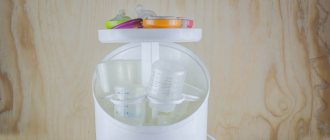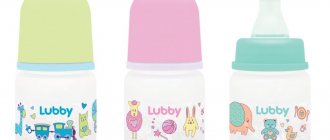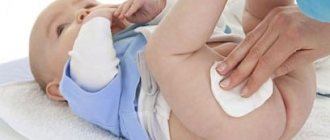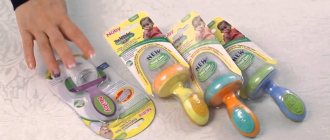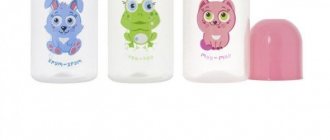Are you still boiling? Then we go to you! On various forums for young mothers, discussions continue as to whether a young family really needs a device for sterilizing baby bottles. The sterilizer has a lot of fans and crowds of ardent opponents. Indeed, our mothers and grandmothers raised us without knowing vacuum cleaners, washing machines and the Internet. In the twenty-first century, all kinds of gadgets are designed to make our lives easier, help us in everyday life, and save time. When caring for a baby, you can never have too much cleanliness; the sterilizer will quickly and reliably destroy germs in bottles, spoons, nipples, pacifiers and other necessary items. Using a special device for sterilization is definitely more convenient than boiling bottles in a saucepan every day.
A bottle sterilizer will make life easier for a young mother
Of course, a bottle sterilizer makes mom’s life a lot easier. But you need to understand that the sterilizer is recommended to be used under certain circumstances.
The convenience of a bottle sterilizer
The sterilizer is very convenient to use. In addition to the fact that modern devices perfectly cope with their primary task, they are very compact, fast and convenient. Sterilizers are able to heat the product evenly from all sides, removing absolutely all microorganisms.
Advantages over conventional boiling
The sterilization process has advantages over boiling. The result will be the same for these two bottle disinfection methods. But the process itself is significantly different. During sterilization, the mother may not worry and temporarily “forget” about the bottles that are placed in the sterilizer. Boiling requires constant monitoring and, if it is ineffective, there is a risk that the bottles will melt, burn, or simply lose their original appearance and shape. Constant boiling also contributes to the appearance of plaque and scale on dishes.
Buy a bottle sterilizer or save money?
This question is the most popular among mothers. Today, experts have divided opinions on the sterilization of children's items. Some believe that disinfecting dishes and various child toys is not at all necessary and is even contraindicated. Because the child should not constantly be in sterile conditions.
Sterile conditions inevitably lead to the development of various allergic diseases and, subsequently, to bronchial asthma.
In the process of growth and development, a child must come into contact with various microorganisms to form immunity. The latter should work from the first months of the child’s life, and not be in “sleep” mode. Because when a baby finds himself in an environment that is aggressive for him, endless illnesses begin, which greatly worry young parents. Experts with this point of view recommend using a sterilizer only in certain situations.
Another opinion is that the child’s imperfect immune and digestive system is not yet ready for various pathogens. Consequently, such experts advise daily sterilization of children's dishes and items that the baby uses. In any case, only parents can decide whether to use a sterilizer or whether they can save money on it.
Full-term babies born from a healthy mother and without serious problems can do without a sterilizer at home. Also, this device may not be needed for babies who are breast-fed.
Concept and functional need
A sterilizer is an invention that helps the modern mother not only efficiently disinfect some children's products, but also save a huge amount of time. Regardless of whether the child is bottle-fed or mixed-fed, pediatricians strongly recommend that parents thoroughly clean all pacifiers, toys, medicinal dispensers, bottles and teethers that the child puts into his mouth.
In general, the gadget is a small container for dishes that is connected to electricity or placed in a microwave oven. Daily use of technology allows you not only to save time on solving everyday problems, but also to protect the baby’s developing immunity. The baby bottle sterilizer is gentler on materials subject to heat treatment than traditional boiling.
The cost of the device depends on its type and the availability of additional functions. The modern market provides a large selection of basic models in the budget segment.
When is a sterilizer necessary?
There are situations when a sterilizer is necessary:
- a child who is bottle-fed is away from home for a long time. In such conditions, the flora is unfamiliar and dangerous, so it is recommended to sterilize bottles, pacifiers, and toys before use;
- if a mother expresses breast milk , then the dishes where it will be stored must be absolutely clean. Therefore, bottles, containers and breast pumps should be sterilized beforehand. These actions are necessary because breast milk is an ideal breeding ground for bacteria;
- premature babies with serious illnesses also need to sterilize objects with which they have direct contact;
- Healthy formula-fed babies may need sterilization. It is necessary for preventive purposes. That is, it is recommended to sterilize bottles from time to time in order to disinfect those areas that are inaccessible during daily treatment;
- All new utensils need to be sterilized. After purchasing bottles, pacifiers, teethers, they must be sterilized before using them.
What can be replaced?
Studying reviews from mothers, we can conclude that the main alternative to a sterilizer is boiling in a regular saucepan. To save time, you can place many items in it at once, including bottles, pacifiers, and more.
As a substitute you can use:
- steamer;
- microwave;
- steam from a kettle boiling over a fire.
Everyone chooses the option that is most convenient for a particular family.
Unlike other disinfection devices, the sterilizer does not leave scale on objects placed in it.
Classification of bottle sterilizers
A sterilizer for children's dishes has different mechanisms of action. All sterilizers can be divided into 3 groups.
Steam
Sterilization of such devices is carried out with hot steam. Steam sterilizers can be divided into electric and microwave ovens. Electric steam sterilizers operate from the mains. They are the most popular because they have a large capacity and can hold up to 8 bottles. This device has a control panel that clearly allows you to control the process. Also, an electric sterilizer is often equipped with several sterilization modes. The disinfection process takes approximately 7 - 15 minutes.
The only disadvantage of this device is its size. Not many people can afford large sizes of the product, especially if the child lives in a small apartment. Microwave steam sterilizers are also very popular. An undeniable advantage is the smaller size. But you need to understand that not every sterilizer can fit in a microwave oven. Therefore, before purchasing, you should evaluate the capacity of the microwave. Since the sterilizer is smaller in size, it means that fewer bottles can be sterilized at a time. The disinfection time depends on the power of the microwave oven and is usually 2 - 4 minutes.
Ultraviolet sterilizers
Based on the neutralization of bottles by ultraviolet light. Such sterilizers are of wide importance for the processing of medical devices. This device does not require water and runs on batteries. It is ideal for travel and in situations where you need to process dishes outside the home. The disadvantage of this sterilizer is its small size.
Chemical sterilizers
The mechanism of these products is to process them using special antibacterial chemicals. Such substances are absolutely harmless to the child. But they can leave a specific smell behind. The sterilization process takes 30 minutes, which is not suitable for everyone. Another disadvantage is that you need to regularly buy antibacterial agents. This sterilizer is also suitable for travel.
What varieties exist
Having decided whether you need a bottle sterilizer, you should understand the range of suitable models. The main criterion by which the choice is made is the operating principle of this device.
Relatively recently, sterilization of children's dishes was carried out using improvised means (steam bath, boiling), but now you can purchase a convenient portable model that disinfects children's accessories even while traveling.
Steam sterilizer
Involves the use of thermal energy and water. When heated, a large amount of steam is formed, in the process almost all microbes die, and surfaces are thoroughly disinfected. Typically, devices are produced as separate electrical devices, as well as in the form of special equipment that is used in microwave ovens.
The first type is convenient and functional; this is where models with an additional steamer function are found. The disadvantages are the cost, as well as the need to use a stationary power source.
Sterilizers for microwave ovens are compact in size, the quality of disinfection is at the level of electrical devices, but they also have a number of disadvantages. Primarily this is used for no more than 4 sets of bottles. The second significant disadvantage is the mandatory absence of metal elements.
The principle of operation is extremely simple: liquid is poured into a hermetically sealed container (it is advisable to use purified or filtered water), and a set of dishes is placed. Under the influence of the maximum possible power, sterilization takes from 2 to 8 minutes, depending on the network voltage and the power of the device.
The principle of “cold” sterilization
In road conditions or while walking, the method of so-called cold sterilization of children's accessories will help. At the same time, water with dissolved chemicals is poured into the container. All processed items are soaked in the solution for a certain time (half an hour or more).
Chemical reagents are positioned by manufacturers as absolutely safe for the baby’s health, but in practice they often change the taste of food. That is why most parents use this method exclusively in emergency cases, for example, long trips, or when it is impossible to use other disinfection methods.
A significant disadvantage of using this method is the limited choice of suitable products, as well as the high risk of purchasing a low-quality counterfeit that is dangerous for a child.
Ultraviolet sterilization
The use of equipment using ultraviolet radiation can also be classified as cold sterilization. The disadvantages are the relatively high cost of the models, which is unacceptable for many young families. Ultraviolet water sterilizers are often used for additional disinfection of children's toys and child care accessories.
What to look for when purchasing
Whenever purchasing children's products, you need to pay attention to the quality and composition of the product. It must comply with standards and be absolutely safe. It is recommended to make a choice in favor of trusted brands that have the appropriate certificates and regularly undergo inspections and testing.
It is also important to understand for what purpose a sterilizer is purchased. For breastfed babies, a microwave steam sterilizer is ideal. If your family travels often, then you should take a closer look at ultraviolet or chemical sterilizers. And for children receiving formula, it is better to purchase an electric sterilizer with a large volume.
Features of choice
Pediatricians recommend correlating the choice of product with the expected frequency of use. If your baby eats exclusively formula, it would be best to purchase a model designed for a larger number of bottles. When purchasing you should consider:
- type of sterilization;
- availability of a program for automatically turning on cyclic sterilization;
- what power source is used (electricity, battery, batteries);
- the ability to display data from the diagnostic system on a digital screen (liquid level, time of start and expected completion of the process);
- number of bottles with wide and narrow necks that can be accommodated;
- average duration of one treatment session;
- value for money;
- weight and size of purchase;
- the presence of an automatic on and off function;
- ease of use for parents of a newborn;
- safety of materials used in production;
- availability of a quality certificate for the product;
- a sufficient length of the cord will allow you to comfortably place the device in the room, without the need to constantly move it;
- the presence of a signal notification about the completion of work;
- additional devices: containers, tongs for removing processed items.
Where is the best place to buy a sterilizer?
You should always purchase children's products in specialized stores, hypermarkets, pharmacies or order through online stores.
Specialized children's stores
Currently, more and more children's stores and hypermarkets are opening, where you can find absolutely any product in the range. Typically, large stores offer only certified goods; confirmation can always be obtained from the seller.
Online platforms with delivery
Brands that offer sterilizers for purchase have their own online store. It can be easily found on the Internet. Delivery is provided in all such stores, the only thing is that some manufacturers may require an additional fee for delivery of goods.
Operating principle and benefits of the sterilizer
An autoclave is a device designed to sterilize dishes.
The devices operate on different power sources, including from a 220 W network. The bacteria elimination procedure is accompanied by an indication (sound, signal). Fully loading the container allows you to observe changes in temperature and time. In this case, programs are set automatically. The equipment consists of a cassette and a square. The sterilizer eliminates up to 99% of pathogenic microorganisms.
Design features:
- The appearance of heaters varies depending on the type of device. However, most are equipped with a heating element, a bowl, a control relay, and an electrical cord;
- Some models allow you to install bottles from a similar manufacturer. However, there are universal devices on the market with a wide container for heating containers of different sizes;
- All autoclaves heat cold and room temperature milk equally. Not everyone has the frozen food function;
- Modern devices have an automatic shut-off option, which prevents the bottles from overheating.
Why use a disinfectant:
- Artificial feeding or the parent being with the child outside the home;
- Storing expressed milk. Natural feeding requires high volumes of nutrition, so when in public places, it is more convenient to use sterilized bottles;
- Premature baby, low weight, weakened body of the child. Such situations force a woman to additionally process care items and dishes;
- Artificial nutrition forces the mother to disinfect utensils several times a day. Using classic boiling takes a lot of time, so a sterilizer is an indispensable assistant. This operating process is simple, the containers do not melt, and there is no scale. Moreover, the woman is sure that the bottles are free of microorganisms.
Attention! When using a steam device, you should be careful when removing the lid, as there is hot air inside the device.
How to care for the device?
Undoubtedly, you need to know how to properly care for the sterilizer so that it can be used for a long time. After the treatment process, the device must be emptied of remaining water, in the case of a steam sterilizer. It is important to rinse with running water and dry. The use of detergents is not required. It is also important to monitor the condition of the inner surface of the sterilizer so that plaque does not form. All dry, disassembled parts should be kept clean.
Caring for the device
The service life is affected not only by the correct choice of product, but also by compliance with the rules of its use. Basic care for a standard baby sterilizer includes the following items:
- Prolonged use may cause scale to form in the container. Electric models are most susceptible to this problem. Adding three tablespoons of citric acid to the water and running the device empty in standard mode will help correct the situation. After the procedure, you need to thoroughly wash all parts.
- Constant monitoring of the water level in the device is required. If the level drops below the minimum, overheating and equipment breakdown are possible.
- Should be stored away from direct sunlight and heating devices.
- Do not expose to contact with abrasive cleaning agents.
- After each use, wipe with a moisture-absorbing cloth, it is better to leave it for airing.
TOP 9 sterilizers for baby bottles
To make it easier to choose a sterilizer, you should highlight the advantages and disadvantages of the most popular brands that produce baby bottle sterilizers.
Philips Avent steam electronic sterilizer
One of the most popular sterilizers, it is reliable, practical and convenient. This device has a large capacity. This product can handle 6 bottles as well as small parts. The sterilizer has 2 baskets for large and smaller items. The device has quite impressive dimensions and weighs about 1.5 kg. The sterilization process takes 6 minutes, and the product is equipped with a self-shut-off function.
Operation of the product is very simple. The sterilizer is made of safe and environmentally friendly materials. Bottles can remain sterile for up to a day. The disadvantages include high power consumption and price, which is approximately 6,900 rubles.
Electric sterilizer Philips AVENT SCF284/03
Steam sterilizer for Philips Avent microwave oven
Before purchasing this product, you need to know the capacity of your microwave oven. A 20 liter CB oven may be small for such a sterilizer. This device is ideal for children receiving mother's milk. Because the product is not designed to sterilize a large number of bottles. The price of the sterilizer is 2900 rubles.
Microwave sterilizer Philips AVENT SCF281/02
Steam sterilizer for the Dr. microwave oven. Brown's
The product, which holds 4 bottles, which are perfectly processed on all sides, is made of safe materials. The disadvantages include the fact that the lid is not fixed, so you need to carefully remove such a sterilizer from the oven. The price is 2000 rubles.
Microwave sterilizer Dr. Brown's
Medica Steam Electric Sterilizer
This option is more budget-friendly, its price corresponds to 2500 rubles. The sterilizer is also large in size and can handle 6 bottles at a time. There is a special level inside the product that can be moved depending on the size of the product placed in the device. Steam treatment lasts about 9 minutes. The product is equipped with a sterilization time countdown and self-shutdown function.
Electric sterilizer CS Medica KIDS CS-28s
Steam Electric Sterilizer Maman
The most budget option that ideally combines all the necessary functions. The price is 1500 rubles. The treatment process lasts 15 minutes and is controlled by a button. The downside is the noise during operation of the sterilizer.
Electric sterilizer Maman BY-03
Tommee Tippee Electric Steam Sterilizer
The device can hold up to 6 bottles. A nice bonus is that the set includes a bottle and a pacifier for the baby. The safe materials from which the sterilizer is made are an undeniable advantage. When closed, the bottles can remain sterile for 24 hours after processing. The disinfection process takes 5 minutes.
The disadvantages include the fact that immediately after treatment the device cannot be opened for some time. And also reviews from mothers indicate that the product should be regularly checked for scale build-up. The price is in the range of 4000 - 4500 rubles.
Microwave sterilizer Tommee Tippee Сloser to Nature
Chicco Steam Electric Sterilizer
This device can hold up to 7 small bottles. Due to its shape, the sterilizer does not take up much space. The disadvantages include the fact that the product needs some time to warm up before the processing process. Sterilization lasts about 5 minutes. An interesting fact is that if you leave products in the sterilizer for a long time, the device will process them every 5 hours. The price starts from 2800 rubles.
Electric sterilizer Chicco SterilNatural 2 in 1
Electric steam sterilizer Dr. Brown's
This sterilizer processes up to 6 bottles of different brands simultaneously. The disinfection process is quite long and lasts 12 minutes. The product is quite large in size, so it is not suitable for everyone. After processing, the device turns itself off. The price is quite high and ranges from 5700 to 6500 rubles.
Electric sterilizer (AC043) Dr. Brown's
Electric steam sterilizer Canpol babies
This product also meets all standards. Can hold up to 6 bottles with both narrow and wide necks. The processing process lasts 10 minutes. The price is about 4000 rubles.
Microwave sterilizer Canpol Babies 2/847
TOP 10 best models
Based on the above characteristics, the TOP 10 looks like this:
- Philips Avent SCF281/02 for microwave.
- Beurer JBY76.
- Philips Avent SCF284/03.
- Beurer JBY40.
- Ramili BSS150.
- TEFAL Baby Home.
- Chicco Steril Natural.
- Tefal Baby Home BH 7300.
- Tommee Tippee Closer to Nature.
- Maman LS-B210.
Instructions for use, or how to use the sterilizer
After feeding the baby, the dishes are prepared for sterilization. The bottle is thoroughly washed with a personal brush in hard-to-reach places. Use salt, soda or a special product approved for infants.
Attention! When using a dishwasher, select detergents suitable for small children. For the safety of the child, rinse the dishes in warm water several times.
- Open the lid and take out the utensil rack. Pour a glass of liquid into the device. A lack of water can cause a malfunction of the mechanism, and an excess will lead to a decrease in the quality of processing.
- Replace the shelf and immerse the bottles turned upside down.
- Close the device with the lid and secure with latches.
- Place the sterilizer in the center of a dry and clean microwave oven.
- Remove the unit by the handles from the microwave oven 3 minutes after cooling to avoid thermal burns.
- Release the latches and open the cover.
Attention! In a closed device, the bottles remain sterile for 24 hours.
Security measures when using the device
- The sterilizer is installed on a dry, flat and durable surface.
- It is strictly forbidden to open the lid of the device while it is running.
- Place the tool out of the reach of children.
- The sterilization procedure is repeated after the device has cooled.
- Clean it periodically from scale.
- Provide gentle care for the product: drain the liquid and wipe dry after use. Rinse removable parts with water.
- Do not immerse the structure in liquid.
- Control the volume of water in the tank.
- Do not overload the unit.
- Monitor the tightness of the lid during sterilization.
